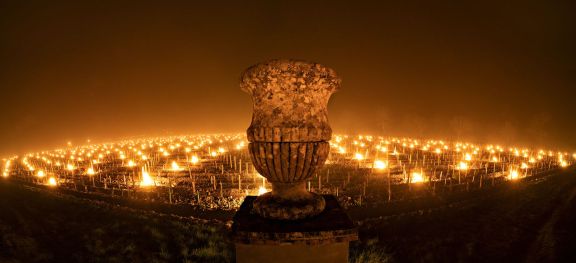Follow-up frost report for Italy

The bad news keeps on coming. Enea Barbieri's picture is of the anti-frost measures taken at Tenuta di Trinoro in southern Tuscany on the night of 7/8 April. See also Frost strikes European vineyards.
Eyewitnesses from Barolo report much greater frost damage in large parts of the Langhe than initially expected. Vineyards at elevations up to 300 m (980 ft) have suffered badly, with the areas around Verduno, Barolo, La Morra, Roero and Barbaresco especially heavily hit and with a predicted loss of up to 50%, while Serralunga d'Alba and Monforte d'Alba seem to have escaped the brunt of the frost so far.
Valtellina has reportedly experienced much less damage than in 2017.
Alarming reports have also arrived from the plains of Emilia-Romagna between Modena and Reggio Emilia, the epicentre of Lambrusco production. Vineyards planted with the early-budding Lambrusco Grasparossa variety have been hit particularly hard, with some producers facing a loss of up to 80%, while all other Lambrusco varieties have suffered too thanks to the warm weather prior to the frost blitz, with vines already budding.
The ice-cold polar airstream resulting in the coldest spring frost since 2003 has caused massive damage to the vast (27,000-ha/67,000-acre) vineyard area of Prosecco DOC. Due to the enormous volumes produced here, Prosecco DOC is regularly subject to price speculation. As happened in 2017 when a spring frost damaged the Prosecco vineyards, followed by a torrid summer reducing yields further, speculation is widely anticipated, along with possible price increases. It is worth noting that after the 2017 frosts these did not materialise in the end. Early-budding varieties such as Chardonnay cultivated on the plains have also been hit hard by the frost.
Coldiretti (Confederazione Nazionale Coltivatori Diretti), Italy's prinicipal farmers' organisation, has expressed concern about the effects of climate change on Italy's agricultural production. An estimated loss of €14 billion in the last decade alone is mentioned
Reports from Montalcino speak of spots of frost damage in vineyards above 350 m (1,150 ft). Lower-lying vineyards in Castelnuovo dell'Abate have also suffered large-scale damage with expected losses of up to 80%.
Become a member to view this article and thousands more!
- 15,414 featured articles
- 275,126 wine reviews
- Maps from The World Atlas of Wine, 8th edition (RRP £50)
- The Oxford Companion to Wine, 5th edition (RRP £50)
- Members’ forum
- 15,414 featured articles
- 275,126 wine reviews
- Maps from The World Atlas of Wine, 8th edition (RRP £50)
- The Oxford Companion to Wine, 5th edition (RRP £50)
- Members’ forum
- 48-hour preview of all scheduled articles
- Commercial use of our wine reviews
